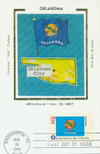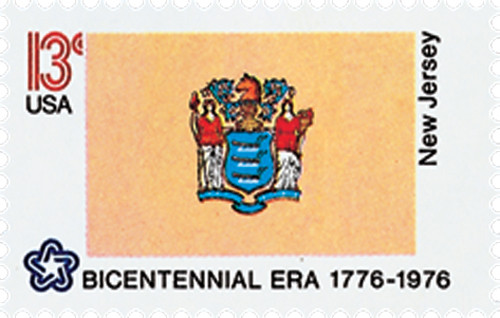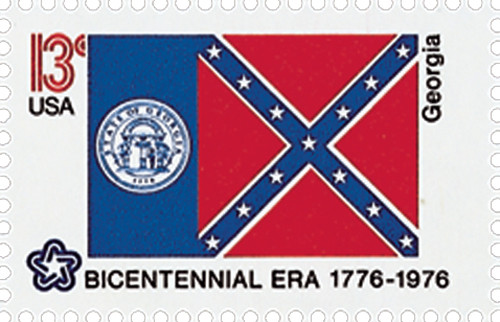
# 1678 - 1976 13c State Flags: Oklahoma
U.S. 1678
1976 Oklahoma
State Flags
American Bicentennial Series
• First time a sheet 50 had all different stamp designs
• Part of the American Bicentennial Series
Stamp Category: Commemorative
Series: American Bicentennial Series
Value: 13¢ First-class postage rate
First Day of Issue: February 23, 1976
First Day City(s): Washington, DC
Quantity Issued: 8,720,100 (panes of 50)
Printed by: Bureau of Engraving and Printing
Printing Method: Photogravure
Format: Sheet of 50
Perforations: 11
Why the stamp was issued:
The United States Postal Service celebrated the American Bicentennial with a full pane of the Union’s fifty state flags.
About the stamp design:
Adopted in 1925, the state flag design was the result of a Daughters of the American Revolution contest. The flag recognizes the important role Native Americans had in founding the state. The blue field commemorates the flag of the Choctaw Indians who fought in the Civil War. The center pictures the buffalo hide shield used by Osage warriors. The small crosses symbolize stars and high ideals. In front of the shield are symbols of peace and unity: a calumet, or peace pipe, is the Native American symbol, and an olive branch represents peace to European settlers. The word OKLAHOMA was added in 1941.
Respect for its Native American history, as demonstrated by the state’s flag, has allowed the citizens of Oklahoma to work together to make their state grow and prosper.
About the printing process:
Printed by the Bureau of Engraving and Printing on their seven-color Andreotti gravure press (601) which was their work horse for multicolored stamps.
About the American Bicentennial Series:
In the 1970s, America celebrated its 200th anniversary with hundreds of national events commemorating the heroes and historic events that led to our nation’s independence from Great Britain. The U.S. Postal Service issued 113 commemorative stamps over a six-year period in honor of the U.S. bicentennial, beginning with the American Revolution Bicentennial Commission Emblem stamp (U.S. #1432). As a group, the Bicentennial Series chronicles one of our nation’s most important chapters, and remembers the events and patriots who made the U.S. a world model for liberty.
Several of the stamps honored colonial life – craftsmen and communication. Other stamps honored important battles including Lexington and Concord, Bunker Hill, and Saratoga. Significant events such as the Boston Tea Party, the meeting of the First Continental Congress, and the Declaration of Independence were featured as well. The stamps also honored many significant people such as George Washington, Sybil Ludington, Salem Poor, and the Marquis de Lafayette.
Many of the stamps feature classic artwork. For instance, the set of four souvenir sheets picture important events recreated by noted artists such as John Trumbull. The Bicentennial Series also includes an important US postal first – the first 50-stamp se-tenant – featuring all 50 state flags. The format proved to be popular with collectors, and has been repeated many times since.
The American Bicentennial Series is packed with important US history – it tells the story of our nation’s fight for independence through stamps.
History the stamp represents:
On November 16, 1907, Oklahoma became the 46th state in the Union.
In 1803, the United States obtained the Oklahoma region from France as part of the Louisiana Purchase.
Starting in the 1820s, the federal government removed the Cherokee, Chickasaw, Choctaw, Seminole, and Creek tribes to the area. These Indians, called the Five Civilized Tribes, were promised that they would own their lands and be protected from white settlement.
After the Civil War, however, Congress forced the Tribes to give up the western part of their land because they had supported the South. Finally, the government bought over 3 million acres in central Oklahoma from the Creek and Seminole tribes and opened over half of it for settlement. At noon, on April 22, 1889, 50,000 settlers raced to stake their claims in the first of six Oklahoma land rushes.
Congress established the Territory of Oklahoma in May 1890, separate from Indian Territory. The Five Civilized Tribes proposed that Indian Territory be made a state, but Congress refused.
Instead, Congress combined the two territories, their fertile farms, rich grazing lands, and developing oil fields, into one state. This stamp commemorates the centennial of November 16, 1907, when Oklahoma became the 46th state in the Union.
U.S. 1678
1976 Oklahoma
State Flags
American Bicentennial Series
• First time a sheet 50 had all different stamp designs
• Part of the American Bicentennial Series
Stamp Category: Commemorative
Series: American Bicentennial Series
Value: 13¢ First-class postage rate
First Day of Issue: February 23, 1976
First Day City(s): Washington, DC
Quantity Issued: 8,720,100 (panes of 50)
Printed by: Bureau of Engraving and Printing
Printing Method: Photogravure
Format: Sheet of 50
Perforations: 11
Why the stamp was issued:
The United States Postal Service celebrated the American Bicentennial with a full pane of the Union’s fifty state flags.
About the stamp design:
Adopted in 1925, the state flag design was the result of a Daughters of the American Revolution contest. The flag recognizes the important role Native Americans had in founding the state. The blue field commemorates the flag of the Choctaw Indians who fought in the Civil War. The center pictures the buffalo hide shield used by Osage warriors. The small crosses symbolize stars and high ideals. In front of the shield are symbols of peace and unity: a calumet, or peace pipe, is the Native American symbol, and an olive branch represents peace to European settlers. The word OKLAHOMA was added in 1941.
Respect for its Native American history, as demonstrated by the state’s flag, has allowed the citizens of Oklahoma to work together to make their state grow and prosper.
About the printing process:
Printed by the Bureau of Engraving and Printing on their seven-color Andreotti gravure press (601) which was their work horse for multicolored stamps.
About the American Bicentennial Series:
In the 1970s, America celebrated its 200th anniversary with hundreds of national events commemorating the heroes and historic events that led to our nation’s independence from Great Britain. The U.S. Postal Service issued 113 commemorative stamps over a six-year period in honor of the U.S. bicentennial, beginning with the American Revolution Bicentennial Commission Emblem stamp (U.S. #1432). As a group, the Bicentennial Series chronicles one of our nation’s most important chapters, and remembers the events and patriots who made the U.S. a world model for liberty.
Several of the stamps honored colonial life – craftsmen and communication. Other stamps honored important battles including Lexington and Concord, Bunker Hill, and Saratoga. Significant events such as the Boston Tea Party, the meeting of the First Continental Congress, and the Declaration of Independence were featured as well. The stamps also honored many significant people such as George Washington, Sybil Ludington, Salem Poor, and the Marquis de Lafayette.
Many of the stamps feature classic artwork. For instance, the set of four souvenir sheets picture important events recreated by noted artists such as John Trumbull. The Bicentennial Series also includes an important US postal first – the first 50-stamp se-tenant – featuring all 50 state flags. The format proved to be popular with collectors, and has been repeated many times since.
The American Bicentennial Series is packed with important US history – it tells the story of our nation’s fight for independence through stamps.
History the stamp represents:
On November 16, 1907, Oklahoma became the 46th state in the Union.
In 1803, the United States obtained the Oklahoma region from France as part of the Louisiana Purchase.
Starting in the 1820s, the federal government removed the Cherokee, Chickasaw, Choctaw, Seminole, and Creek tribes to the area. These Indians, called the Five Civilized Tribes, were promised that they would own their lands and be protected from white settlement.
After the Civil War, however, Congress forced the Tribes to give up the western part of their land because they had supported the South. Finally, the government bought over 3 million acres in central Oklahoma from the Creek and Seminole tribes and opened over half of it for settlement. At noon, on April 22, 1889, 50,000 settlers raced to stake their claims in the first of six Oklahoma land rushes.
Congress established the Territory of Oklahoma in May 1890, separate from Indian Territory. The Five Civilized Tribes proposed that Indian Territory be made a state, but Congress refused.
Instead, Congress combined the two territories, their fertile farms, rich grazing lands, and developing oil fields, into one state. This stamp commemorates the centennial of November 16, 1907, when Oklahoma became the 46th state in the Union.


















